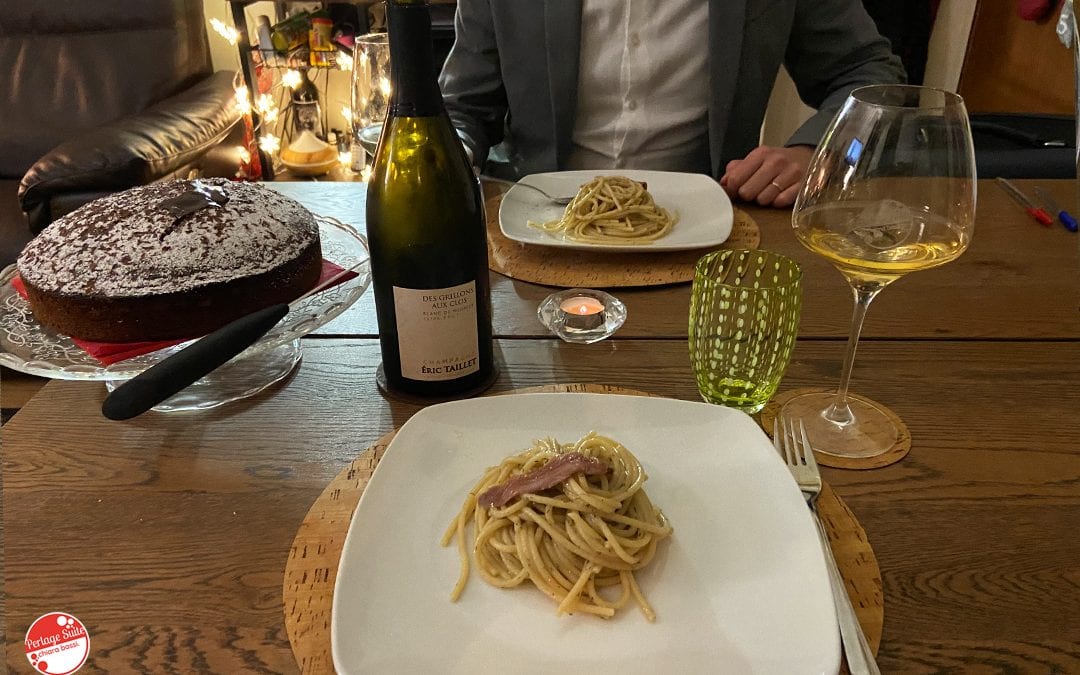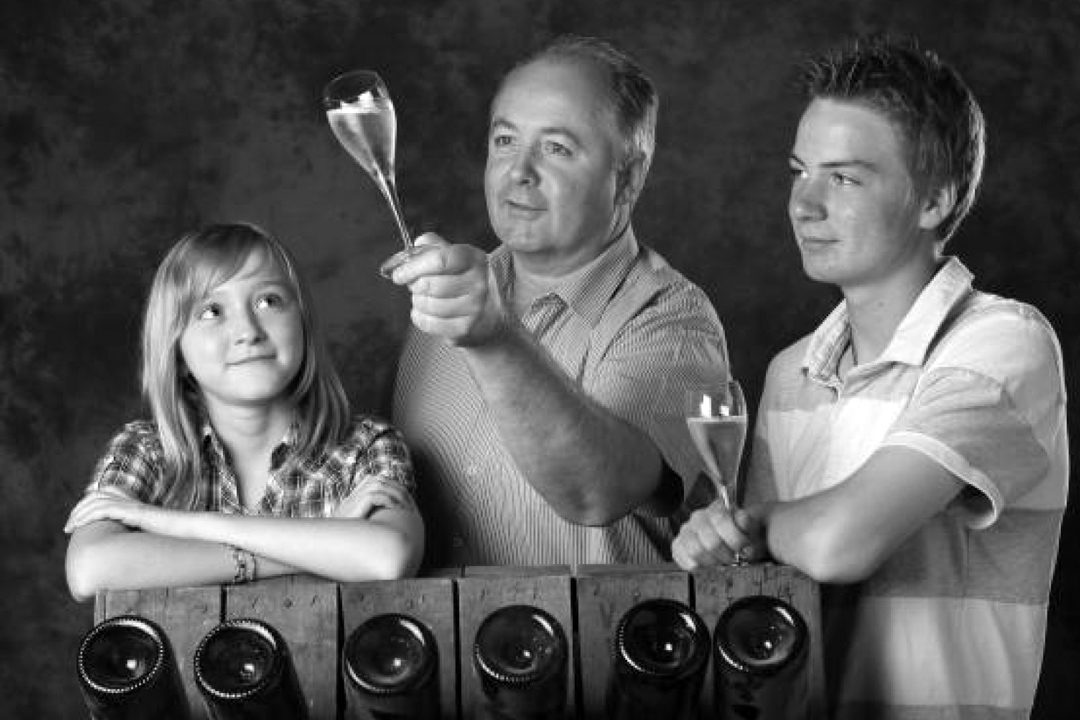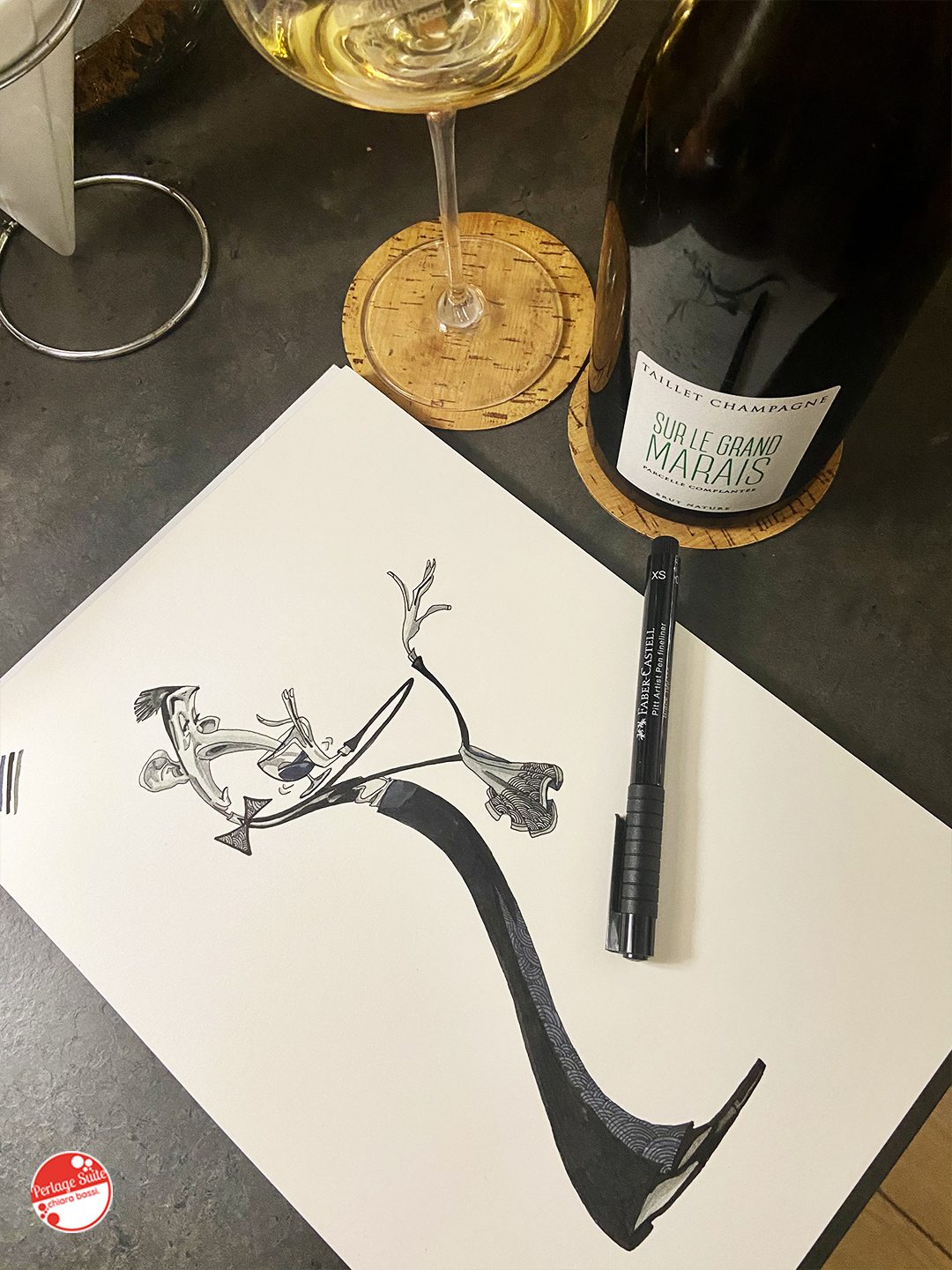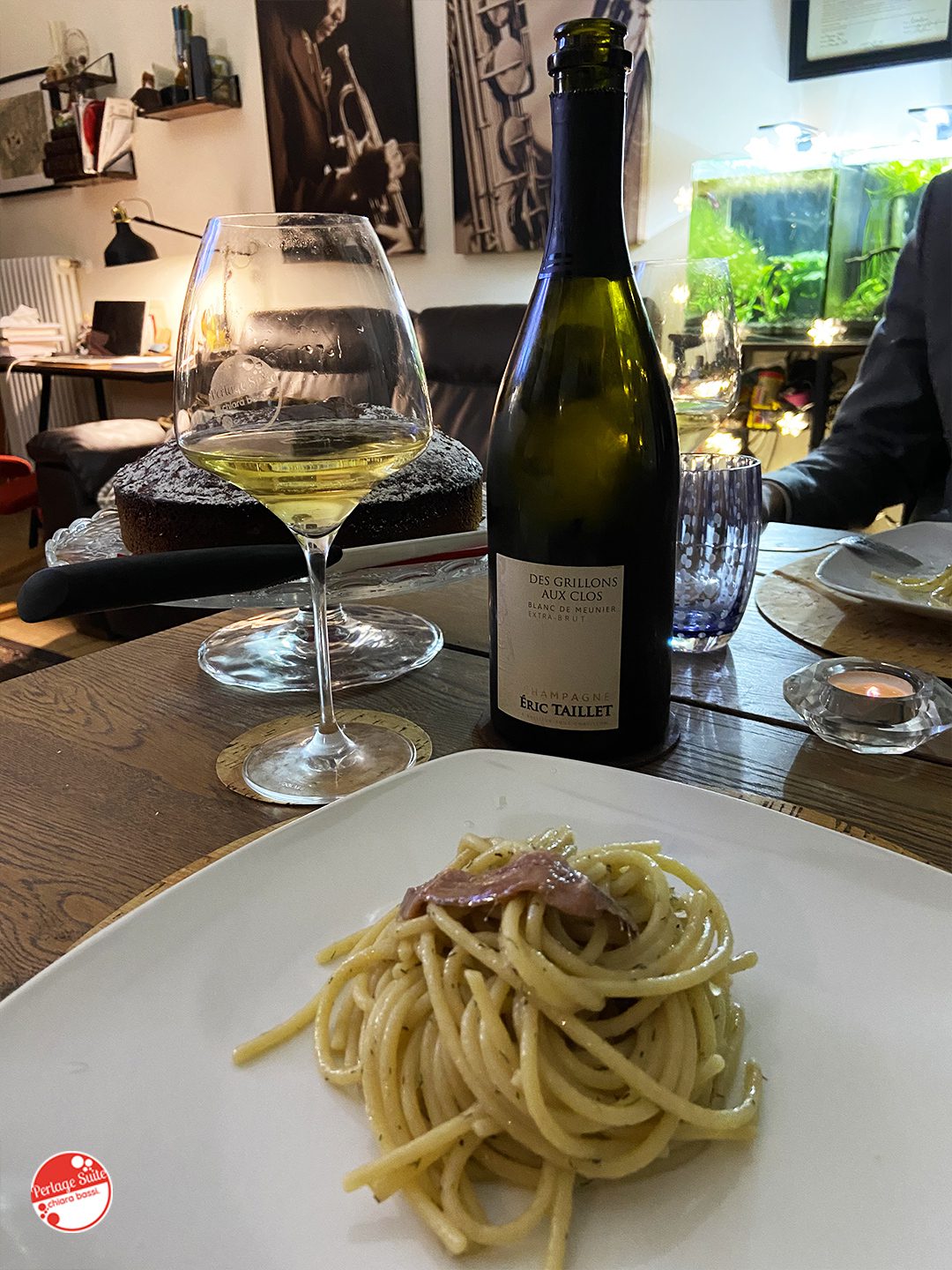I had already decided that yesterday afternoon I would uncork "Sur Le Grand Marais" Champagne Brut Nature by Eric Taillet. A wise Charles Buckowski said roughly: 'If something good happens you drink to celebrate, if something bad happens you drink to forget and if nothing happens you drink to make something happen'. Thus, having yesterday at 2pm the Food and Wine Science and Technology, at 13:45 I uncorked this bottle I did not know and relaxed and basked in its deliciousness. Then since I passed the exam brilliantly I now need 29 bottles to celebrate... Meanwhile, thanks to Alberto Massucco Champagne and to Laura Gobbi (whom I don't know personally yet, but he inspires me a lot!) for letting me discover this winery that I didn't know (and I have others to discover with them...)! 😍
Champagne, thank you!
For me, Champagne - classic method sparkling wine in general - is a fundamental ingredient in my life. It is certainly no coincidence that my wine blog is actually called Perlage Suite. Perlage is the effervescence, it is that fine necklace of pearls (hence the name) forming that 'chain' of small bubbles going from the bottom to the top. Not to be confused with the fizzy, scratchy feeling in your throat and stomach that carbonated water gives you, which I just can't stand. When I chose this name, I didn't do it just to tell you about sparkling wines, but rather to tell you something about myself and my lifestyle.
Luxury as a lifestyle
For me, enormous human complexity can be distinguished into two categories of people: the one who eats every day on the ugly plate and then looks cool when he has guests with the super plate - open heavens if he chips one - and the one who eats every day on the most beautiful plate regardless of whether he is alone or with company - if he chips one he buys another. I live with effervescence, to the max, always. I don't have to prove anything: I love my mise en place and enjoy it every day of the year. I work from home and 5 days out of 7 I live in my pyjamas. If when I go out I don't show up in 12 heels and cleavage, it's because in 12 heels my feet hurt and my boobs aren't showing. I like to be comfortable and I've made my peace with that. Champagne, which has always been an emblem of a luxurious lifestyle, is associated with the culture of appearance, which is something far removed from true luxury: the freedom to be oneself. Always and everywhere, regardless of events, by seasonal trendsby the hands shaking... Champagne is always faithful to the style of its maison no matter what happens. A Champagne does not have to prove that it is precious, it just is. Then there are many styles for many palates, but that's another story. And that is exactly what happens with people.
To understand where we come from, where we are and where we are going in order to be true to ourselves, that is true luxury. And, as we do so, we uncork Champagne, feel the pleasure inebriate our sense of smell and go down our throats.
This life is a true Perlage Suite!
Talk about styles for many palates, Eric Taillet was truly an incredible discovery. Let's start with a fact: I love the Pinot Meunier. Its name 'meunier' means miller and derives from the fact that the lower part of the leaf is covered with a white fluff that makes it look like flour. I have tasted many champagnes and realised that the producers of Meunier are divided into two factions: on the one hand, those who bet everything on oxidative notes and on the other, those who bet everything on acidity. What I realised about this grape variety is that it has the ability to express itself brilliantly in both senses. Let's start with the oxidative notes: I adore them and by now everyone really knows. Often in discussions with colleagues and enthusiasts, I have seen that one confuses a pleasant oxidation with a wine that is gone, mature, at the end of its life cycle. And this happens both ways: exceptional wines have been called 'gone' and objectively 'gone' wines have been portrayed to me as fabulous. I believe that this is due to errors in cellar management, wrong drinking habits and above all to having drunk little (and badly).
Eric Taillet pleasantly sent me into confusion because his Sur Le Grand Marais Brut Nature is neither one nor the other, but a perfect balance between these two ways of interpreting Meunier.
Eric Taillet Champagne 'Sur Le Grand Marais', Brut Nature
Multivintage 2014-2015, Degorgement 11/2019 90% pinot meunier, 10% chardonnay
This champagne is made from a cuvée that originates from old vineyards dating back to the early 1900s and located in the Vallée de la Marne. Most of the vines were replanted in 1986 following a frost. Harvesting takes place at the same time to seek maturity in the pinot meunier and freshness in the chardonnay. Fermentation mostly in wood, blending of two vintages and over 4 years on the lees as bouchon liège. It is a beautiful, bright, intense straw yellow with antique gold hues. The bubbles are numerous, fine and persistent. The nose is characteristic of meunier with slightly oxidised notes of butter, white chocolate, candied pear, orchid flowers (I could tell you the species... Brassocattleya talie!). In the mouth it is very fresh, crisp, saline and well balanced, with great structure and persistence.
I would advise against combining it with tasty cheeses and grilled food because you would lose it. To make the most of it, go for a very simple recipe... spaghettoni with butter, anchovies and dill!
Eric Taillet Champagne "Des Grillons Aux Clos", Extra Brut
Degorgement 02/2020 100% pinot meunier dosed at 1.3 g/l with 2004 wine
What a spectacle the new sans année by Eric Taillet! Parcel selection of old Meunier vines in the heart of the Vallée de la Marne, through 12 vineyards on clay soil and limestone subsoil. The wines remain on the noble lees until blending, without racking, part in steel, part in wood, without malolactic fermentation and avoiding cold maceration or filtration. The champagne is the fruit for the 70% of the last harvest (2017) and for the rest of a réserve perpétuelle which currently has nine vintages.
It is a beautiful, bright, intense straw yellow with golden hues. On the nose, lots of fresh toasted hazelnut, butter, bread crust, graphite and saltiness. In the mouth it is fresh, crisp and savoury, vertical. Good persistence and exceptional drinkability. In my opinion, you can really feel the calcareous soils in which the vines have sunk their roots.
Eric Taillet Champagne and Spaghettoni with butter, anchovies and dill: my recipe
An easy and tasty recipe for a perfect combination of enhancement!
.
Let us start with an assumption: when ingredients are few, the secret is quality. This recipe has only three ingredients: butter, anchovies and noodles. If you like - I highly recommend it - you can add a teaspoon of dried dill.
Ingredients for 2 diners
- 250g large spaghetti (I recommend Afeltra spaghettoni or 'il Valentino' by Monograno Felicetti);
- butter from centrifuged cream (I use butter from a farm in the Ardennes, among commercial butters you can use Beppino Ocelli's);
- 12 fillets of anchovies in oil;
- the tip of a teaspoon of dried dill.
Very easy to prepare in 15 minutes (cooking time of the pasta):
- Bring the water to the boil and, in a non-stick, high-sided pan, melt half the butter with 8 anchovies over very low heat (I use 3 with induction).
- As soon as the water boils throw in the spaghetti and keep the cooking time minus 4 minutes. So if the pasta cooks in 14 minutes, drain it after 10 with a noodle scoop directly into the wok with the butter and anchovies. You will need about 1 ladle of cooking water to complete, turning up the heat to medium. Stir with a wooden or silicone spoon until the cooking water is completely absorbed.
- Turn off the heat, add the dill and a knob of butter, stirring quickly so that it melts with the heat but does not melt completely. Serve with 2 whole anchovies per plate.
Advice:
- Use dried dill to let it absorb that delicious buttery note as it rehydrates with moisture in the pan.
- Put the dill in at the end of the cooking time so that it does not take on a bitter taste.
- When the anchovies are completely melted turn off the heat so that the butter does not turn to toasted notes.
- Butter when it is good is never enough, says Julia Child.
I am absolutely certain that this dish will win you over. It is a tasty enhancement combination that is designed to make these two Eric Taillet Champagne even more special. The anchovies enhance its salinity and the butter gives it fragrance, softness and slipperiness that is immediately deflated by the champagne. The dill accompanies the delicate aromas without overpowering them.
The recipe is freely inspired by the bigoi in sauce that were eaten on lean days in the Veneto region, especially on Christmas Eve. Being a poor man's dish, the original recipe uses salted sardines (as well as other ingredients), but for taste and practicality I prefer good anchovies in oil. If you don't use the classic method, you can also try putting some fried breadcrumbs in a little oil to complement it, giving the dish a slippery, crispy texture. With the classic method I would advise against this because this type of toasting covers the wine's aromas, unless it is a very structured rosé.
Since you're definitely staying at home this year, how about trying it with one of these champagnes?
Cheers 🥂
Chiara





